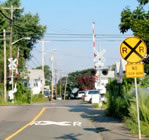Highway-Rail Grade Crossings Overview
 Highway-railroad grade crossings are intersections where a highway crosses a railroad at-grade. They are also called level crossings in other countries such as Canada, Australia, and the United Kingdom.
Highway-railroad grade crossings are intersections where a highway crosses a railroad at-grade. They are also called level crossings in other countries such as Canada, Australia, and the United Kingdom.
To avoid collisions, warning/control devices are required at grade crossings just like intersecting roads need stop signs or traffic signals. Active Grade Crossings have active warning and control devices such as bells, flashing lights, and gates, in addition to passive warning devices such as crossbucks (the familiar x-shaped signs that mean yield to the train), yield or stop signs and pavement markings. While passive Grade Crossings have only passive warning devices. These warning/control devices are specified in the Manual of Uniform Traffic Control Devices (MUTCD).
Grade crossings may be public or private. Public grade crossings are roadways that are under the jurisdiction of, and maintained by, a public authority. Private grade crossings are on privately owned roadways, such as on a farm or industrial area, and are intended for use by the owner or by the owner's licensees and invitees. A private crossing is not intended for public use and is not maintained by a public highway authority. In 2015, there were 129,582 public crossings and 80,073 private crossings.
 Collisions between highway vehicles and trains have been, until recently (1996), the greatest source of injuries and fatalities in the railroad industry. As a result of the Grade Crossing Action Plan, and the continuous research effort funded by the FRA, the number of fatalities and injuries at grade crossings has decreased by almost 40 percent within the decade (2001 – 2011) and has a slight increase in 2014. While trespassing fatalities decreased by approximately 21 percent within the same decade (2001 – 2011) and have increased by 29% since 2011. Since 1997, the number of trespassers fatalities along the railroad's right-of-way exceeded those fatalities at grade crossings. The FRA Office of Railroad Safety develops detailed statistics on the railroad industry's safety.
Collisions between highway vehicles and trains have been, until recently (1996), the greatest source of injuries and fatalities in the railroad industry. As a result of the Grade Crossing Action Plan, and the continuous research effort funded by the FRA, the number of fatalities and injuries at grade crossings has decreased by almost 40 percent within the decade (2001 – 2011) and has a slight increase in 2014. While trespassing fatalities decreased by approximately 21 percent within the same decade (2001 – 2011) and have increased by 29% since 2011. Since 1997, the number of trespassers fatalities along the railroad's right-of-way exceeded those fatalities at grade crossings. The FRA Office of Railroad Safety develops detailed statistics on the railroad industry's safety.
